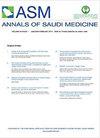Seroprevalence of SARS-Cov-2 IgG antibodies in patients at a single center in Saudi Arabia
IF 1.8
4区 医学
Q2 MEDICINE, GENERAL & INTERNAL
引用次数: 1
Abstract
BACKGROUND: The coronavirus disease 2019 (COVID-19) pandemic has had a massive impact on public health as well as the economy. Understanding the seroprevalence of severe acute respiratory syndrome coronavirus 2 (SARS-CoV-2) infection among undiagnosed individuals is important for developing an informed pandemic response. OBJECTIVE: Investigate the prevalence of undiagnosed COVID-19 disease. DESIGN: Cross-sectional. SETTING: Tertiary care center in Madinah, Saudi Arabia. SUBJECTS AND METHODS: All participants were on follow-up visits to various clinics and had not been previously diagnosed with COVID-19. Enzyme-linked immunosorbent assay was used to specifically assess the anti-spike IgG antibody seropositivity in serum samples. We associated the seropositivity rates of the participants with age, body mass index (BMI), nationality, blood groups, and sex with uni- and multivariate analyses. MAIN OUTCOME MEASURES: Seropositivity for IgG anti-spike antibodies against SARS-CoV-2. SAMPLE SIZE AND CHARACTERISTICS: 527 subjects, with a median (interquartile percentiles) age of the 527 subjects was 34 (24–41). RESULTS: Of the 527 samples, about one-fourth (n=124, 23.5%) were positive for anti-spike IgG antibody against SARS CoV-2. Age was associated with anti-spike IgG antibody positivity (P<.002). Participants >30 years were more likely to be seropositive (28-29%) than younger participants (15.4%). Additionally, seropositivity was associated with female gender (P<.001) and a higher BMI (P<.006). In the multivariate logistic regression, age >30, female gender and BMI >40 were associated with seropositivity. CONCLUSION: The percentage of seropositive individuals reflects the high level of undiagnosed COVID-19 patients among the population. Our results will help in a better evaluation of the public health measures applied during the COVID-19 pandemic and any future public health crises. LIMITATIONS: Sample size was small, single-center study and no rural areas were included. CONFLICT OF INTEREST: None.沙特阿拉伯单一中心患者中SARS-Cov-2 IgG抗体的血清阳性率
背景:2019冠状病毒病(新冠肺炎)大流行对公共卫生和经济产生了巨大影响。了解未确诊个体中严重急性呼吸综合征冠状病毒2型(严重急性呼吸系统综合征冠状病毒冠状病毒2型)感染的血清流行率对于制定知情的大流行应对措施很重要。目的:调查未确诊新冠肺炎的患病率。设计:横截面。单位:沙特阿拉伯麦地那的三级护理中心。受试者和方法:所有参与者都在各个诊所进行随访,之前未被诊断为新冠肺炎。酶联免疫吸附试验用于特异性评估血清样品中的抗刺突IgG抗体血清阳性。我们通过单因素和多因素分析将参与者的血清阳性率与年龄、体重指数(BMI)、国籍、血型和性别联系起来。主要观察指标:抗严重急性呼吸系统综合征冠状病毒2型IgG抗刺突抗体血清阳性。样本量和特征:527名受试者的中位(四分位数间)年龄为34岁(24-41岁)。结果:在527份样本中,约四分之一(n=124,23.5%)的SARS冠状病毒2型抗刺突IgG抗体呈阳性。年龄与抗刺突IgG抗体阳性相关(P30岁的参与者血清阳性率(28-29%)高于年轻参与者(15.4%)。此外,血清阳性与女性相关(P30,女性和BMI>40与血清阳性有关。结论:血清阳性个体的百分比反映了人群中未确诊新冠肺炎患者的高水平。我们的结果将有助于更好地评估新冠肺炎大流行和任何未来公共卫生危机期间采取的公共卫生措施。限制:样本量小,单一er研究,不包括农村地区。利益冲突:无。
本文章由计算机程序翻译,如有差异,请以英文原文为准。
求助全文
约1分钟内获得全文
求助全文
来源期刊

Annals of Saudi Medicine
医学-医学:内科
CiteScore
2.80
自引率
0.00%
发文量
44
审稿时长
4-8 weeks
期刊介绍:
The Annals of Saudi Medicine (ASM) is published bimonthly by King Faisal Specialist Hospital and Research Centre, Riyadh, Saudi Arabia. We publish scientific reports of clinical interest in English. All submissions are subject to peer review by the editorial board and by reviewers in appropriate specialties. The journal will consider for publication manuscripts from any part of the world, but particularly reports that would be of interest to readers in the Middle East or other parts of Asia and Africa. Please go to the Author Resource Center for additional information.
 求助内容:
求助内容: 应助结果提醒方式:
应助结果提醒方式:


